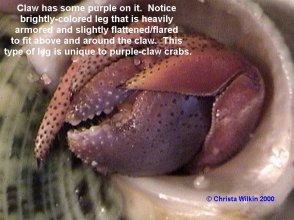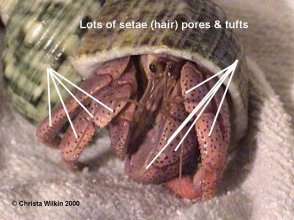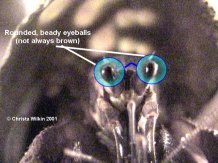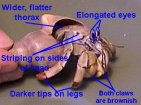What species of
crab do I have?
What Kind of Hermit Crab do I Have?
In the United States there are two main species commonly
sold as pets. The descriptions below describe those two. Coenobita
clypeatus. It is native to the Caribbean and has many common names,
such as purple pincher (abbreviated to PP), land hermit crab, tree
crab, soldier crab, and Caribbean crab. The second species is Coenobita
compressus, whose common names are Ecuadorian Crab, E-Crab, E or
the affectionate nickname, "Eccie." It is highly likely that if you
live in the United States, you have one or both of these two species of
crabs.
However, if
you purchased your hermit crab from a mall kiosk or a Petco, there is a
chance that you could have what is called an "exotic breed"
of hermit crab. The exotics are imported to the United States from the
Pacific Rim. If you view the identifying information below and it does
not seem to fit or look like your crab, please visit the Exotics webpage for information on identifying
your exotic land hermit crab. I suggest you review the Exotics
page anyway, because it will help contribute to your overall knowledge
about hermit crabs, plus you will be able to make a definitive
identification of your land hermit crab.
How Can I Tell Which is Which?
There are a few key differences between the two species,
First, let’s take a look at some pictures of Purple Pincher crabs.

As you
can see in the picture of the PP crab to the right, he has a large,
purple claw. Usually the claw has a lighter-colored tip, but not always.
Now we will
view a second difference in the two species of crabs.  See the PP
crab in the picture to the left? He has many speckles on
his legs and claws. The speckles are sort of the hermit crab
equivalent of
hair follicles. They are called setae. Setae are hair-like
filaments of chitin, the material that makes up the crab’s exoskeleton.
They do not ‘grow’ from the exoskeleton, like a human hair grows from a
human scalp, but are shed along with the exoskeleton during the molting
process. Typically, a PP crab will have more setae on its body than an
Ecuadorian crab (which only has small tufts on the front edge of both
claws.)
See the PP
crab in the picture to the left? He has many speckles on
his legs and claws. The speckles are sort of the hermit crab
equivalent of
hair follicles. They are called setae. Setae are hair-like
filaments of chitin, the material that makes up the crab’s exoskeleton.
They do not ‘grow’ from the exoskeleton, like a human hair grows from a
human scalp, but are shed along with the exoskeleton during the molting
process. Typically, a PP crab will have more setae on its body than an
Ecuadorian crab (which only has small tufts on the front edge of both
claws.)
Now look
at another PP crab in the picture to the right. You can see
in the  highlighted circles how round this crab's eyes
are. He is another purple pincher crab. Purple pincher
crabs have very round eyes, but may have a slightly flattened lower
portion to the eye. For this reason you should not rely on eye
shape alone in determining the species of your crab. Look at all
the other elements discussed here, body shape, setae coverage, claw
coloring, etc. PP
crabs’ usually have a brown/tannish head, and legs a darker
purple/brown with more with more red or orange. The smaller crabs
especially will have a tan head with a dark ‘spot’ in the center. As
for the legs, the left-most walking leg, as pointed out at the top of
the
page, is specially adapted to fit around the large claw. It is heavily
armored and usually colored a deeper color than the rest of the body
with an orange/yellow tip
highlighted circles how round this crab's eyes
are. He is another purple pincher crab. Purple pincher
crabs have very round eyes, but may have a slightly flattened lower
portion to the eye. For this reason you should not rely on eye
shape alone in determining the species of your crab. Look at all
the other elements discussed here, body shape, setae coverage, claw
coloring, etc. PP
crabs’ usually have a brown/tannish head, and legs a darker
purple/brown with more with more red or orange. The smaller crabs
especially will have a tan head with a dark ‘spot’ in the center. As
for the legs, the left-most walking leg, as pointed out at the top of
the
page, is specially adapted to fit around the large claw. It is heavily
armored and usually colored a deeper color than the rest of the body
with an orange/yellow tip
 Moving on to the identification of the Ecuadorian crabs, check out the
picture to the left. Note specifically the elongated eyes, striping on
the sides of the
head, wider, flatter thorax, same-colored claws and darker leg tips of
the
Ecuadorian crab to the left, and compare them with highlighted, round
eyes of
the purple-pincher crab picture above. Big difference!
Moving on to the identification of the Ecuadorian crabs, check out the
picture to the left. Note specifically the elongated eyes, striping on
the sides of the
head, wider, flatter thorax, same-colored claws and darker leg tips of
the
Ecuadorian crab to the left, and compare them with highlighted, round
eyes of
the purple-pincher crab picture above. Big difference!
As previously
mentioned, the Ecuadorian crab's left-most walking leg is not as
heavily 'modified' as the purple pincher's. The Ecuadorian
crosses its two left-sided walking legs over
its large claw to "close its door." Also, Ecuadorian crabs vary greatly
in color. There are
Ecuadorian crabs that are bright yellow, dark gray, orange and tan.
More often they are a tan color, but sometimes have a bluish tint to
their bodies or the insides of their legs. On many Ecuadorian crabs,
the last segment of their walking legs is a darker tint than the rest
of the body. To make things even more confusing, Ecuadorian crabs have
a tendency to change their exoskeleton colors during their molts. Your
tan crab will bury for its molt, and then come up in a month as a light
lavender shade! The color change is a direct result of their diet -- a
crab that is not eating enough carotene will have a washed-out
appearance after molting. To read about sources of carotene, check the Food and Feeding page.
My
Ecuadorians are Hyperactive!
It is well-known that Ecuadorian crabs are usually about 50% more
active than similarly-sized PP crabs. They run much faster than PP
crabs and can seem to run in all directions at once -- forwards,
backwards, even sideways! They also really enjoy climbing on anything
in the tank you provide for them. Some of the smaller Ecuadorian crabs
have been known to grasp the silicone sealant in the corners of the
aquarium (which holds the panes of glass together), and, by climbing,
claw-over-claw, actually climb the glue and escape the tank. You should
always have a well-fitting lid on your crabitat, and this is even more
important when you have Ecuadorians.
They
Make Noise!
Yes, they do! Ecuadorian crabs often communicate with each
other by a squealing, chirping noise, especially when one crab climbs
on top of the other. It is not known how they produce this sound, which
can be quite loud and insistent! Don’t worry if your Ecuadorians chirp
a lot, unless you hear the chirping getting louder and louder, and
realize there is a ‘shell fight’ going on. Of course, in the event of a
shell fight, you should separate the crabs, for the safety of both of
them. If you want to read up on their fascinating vocalizations,
click here to find out more.
My
Ecuadorian’s Shell is Way Too Small, but he Refuses to Change!
It’s a common complaint of owners of Ecuadorian crabs that they
don’t like to switch shells as often as the PP crabs. As you may have
noticed, your Ecuadorian crab is in a shell with a more slotted opening
than the PP crabs’ shells. Ecuadorians have a wider, flatter-shaped
abdomen, which is why they prefer shells with slot-shaped openings.
They have a special preference for shells from their native habitat. If
you are purchasing Ecuadorian crabs for the first time, it is strongly
advised that you select some recently-vacated shells (with slot-shaped
openings) from the pet store where you bought your Ecuadorian crab,
since it is likely that you will not have any of their ‘preferred’
shells at home.
Anything
Else I Should Know?
Only this -- Ecuadorian crabs really like to have the company of
their own species, so if you are interested in purchasing one, it is
strongly recommended that you purchase him or her a friend. They
actually seem to slow down in activity and get ‘depressed’ when they
are without another Ecuadorian ‘buddy.’ So please, do not buy just
one.
Home Page Behavior & Aggression/Basic Care/Chirping/Convention Happenings/ FAQs/Food & Feeding/My Links/Molting/Nocturnal Behavior/Shells
& Shell Pictures/Species Identification/About Me
© Christa Wilkin 2011
 highlighted circles how round this crab's eyes
are. He is another purple pincher crab. Purple pincher
crabs have very round eyes, but may have a slightly flattened lower
portion to the eye. For this reason you should not rely on eye
shape alone in determining the species of your crab. Look at all
the other elements discussed here, body shape, setae coverage, claw
coloring, etc. PP
crabs’ usually have a brown/tannish head, and legs a darker
purple/brown with more with more red or orange. The smaller crabs
especially will have a tan head with a dark ‘spot’ in the center. As
for the legs, the left-most walking leg, as pointed out at the top of
the
page, is specially adapted to fit around the large claw. It is heavily
armored and usually colored a deeper color than the rest of the body
with an orange/yellow tip
highlighted circles how round this crab's eyes
are. He is another purple pincher crab. Purple pincher
crabs have very round eyes, but may have a slightly flattened lower
portion to the eye. For this reason you should not rely on eye
shape alone in determining the species of your crab. Look at all
the other elements discussed here, body shape, setae coverage, claw
coloring, etc. PP
crabs’ usually have a brown/tannish head, and legs a darker
purple/brown with more with more red or orange. The smaller crabs
especially will have a tan head with a dark ‘spot’ in the center. As
for the legs, the left-most walking leg, as pointed out at the top of
the
page, is specially adapted to fit around the large claw. It is heavily
armored and usually colored a deeper color than the rest of the body
with an orange/yellow tip
 See the PP
crab in the picture to the left? He has many speckles on
his legs and claws. The speckles are sort of the hermit crab
equivalent of
hair follicles. They are called setae. Setae are hair-like
filaments of chitin, the material that makes up the crab’s exoskeleton.
They do not ‘grow’ from the exoskeleton, like a human hair grows from a
human scalp, but are shed along with the exoskeleton during the molting
process. Typically, a PP crab will have more setae on its body than an
Ecuadorian crab (which only has small tufts on the front edge of both
claws.)
See the PP
crab in the picture to the left? He has many speckles on
his legs and claws. The speckles are sort of the hermit crab
equivalent of
hair follicles. They are called setae. Setae are hair-like
filaments of chitin, the material that makes up the crab’s exoskeleton.
They do not ‘grow’ from the exoskeleton, like a human hair grows from a
human scalp, but are shed along with the exoskeleton during the molting
process. Typically, a PP crab will have more setae on its body than an
Ecuadorian crab (which only has small tufts on the front edge of both
claws.)
